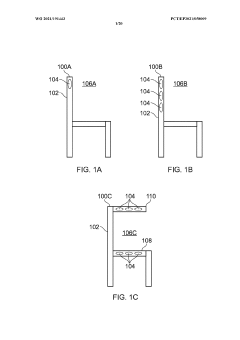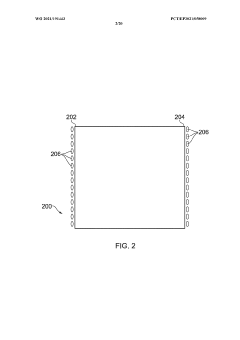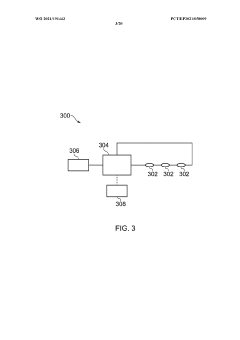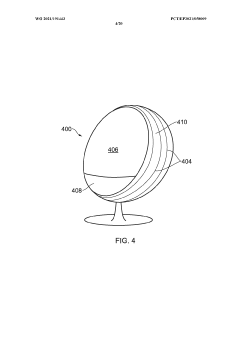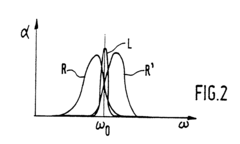Schumann Resonance: Advancing Our Understanding of Climate
JUN 24, 20259 MIN READ
Generate Your Research Report Instantly with AI Agent
Patsnap Eureka helps you evaluate technical feasibility & market potential.
Schumann Resonance Background and Research Objectives
Schumann Resonances, discovered by Winfried Otto Schumann in 1952, are global electromagnetic resonances generated and excited by lightning discharges in the cavity formed by the Earth's surface and the ionosphere. These resonances occur at extremely low frequencies (ELF) with fundamental modes around 7.83 Hz and its harmonics. The study of Schumann Resonances has evolved significantly over the past seven decades, transitioning from a curiosity in atmospheric electricity to a valuable tool in climate research.
The primary objective of advancing our understanding of climate through Schumann Resonance research is to leverage these natural phenomena as a global thermometer. Schumann Resonances are sensitive to changes in the Earth's climate system, particularly to variations in global temperature, atmospheric water vapor content, and the frequency and intensity of lightning activity. By monitoring and analyzing these resonances, researchers aim to gain insights into global climate patterns and their long-term trends.
One of the key goals is to establish a robust correlation between Schumann Resonance parameters and various climate indicators. This includes investigating how changes in global temperature affect the intensity and frequency of Schumann Resonances, and how these resonances respond to variations in the Earth's water cycle. Researchers are particularly interested in using Schumann Resonances as a proxy for global lightning activity, which is closely linked to atmospheric convection and temperature.
Another important objective is to develop more accurate and comprehensive models of the Earth-ionosphere cavity. These models are crucial for interpreting Schumann Resonance data in the context of climate change. By improving our understanding of how various atmospheric and ionospheric parameters influence Schumann Resonances, we can better isolate and interpret climate-related signals within the resonance data.
The research also aims to explore the potential of Schumann Resonances in detecting and monitoring extreme weather events and climate anomalies. This includes investigating how phenomena such as El Niño, tropical cyclones, and severe thunderstorms manifest in Schumann Resonance measurements. Such applications could provide valuable early warning systems and contribute to our understanding of the Earth's climate dynamics.
Furthermore, there is a growing interest in using Schumann Resonance research to study the complex interactions between the Earth's climate and the near-space environment. This includes investigating how solar activity and geomagnetic disturbances influence the Earth-ionosphere cavity and, consequently, the climate system. By bridging the gap between atmospheric and space physics, Schumann Resonance research offers a unique perspective on the Earth's climate as an integrated system.
The primary objective of advancing our understanding of climate through Schumann Resonance research is to leverage these natural phenomena as a global thermometer. Schumann Resonances are sensitive to changes in the Earth's climate system, particularly to variations in global temperature, atmospheric water vapor content, and the frequency and intensity of lightning activity. By monitoring and analyzing these resonances, researchers aim to gain insights into global climate patterns and their long-term trends.
One of the key goals is to establish a robust correlation between Schumann Resonance parameters and various climate indicators. This includes investigating how changes in global temperature affect the intensity and frequency of Schumann Resonances, and how these resonances respond to variations in the Earth's water cycle. Researchers are particularly interested in using Schumann Resonances as a proxy for global lightning activity, which is closely linked to atmospheric convection and temperature.
Another important objective is to develop more accurate and comprehensive models of the Earth-ionosphere cavity. These models are crucial for interpreting Schumann Resonance data in the context of climate change. By improving our understanding of how various atmospheric and ionospheric parameters influence Schumann Resonances, we can better isolate and interpret climate-related signals within the resonance data.
The research also aims to explore the potential of Schumann Resonances in detecting and monitoring extreme weather events and climate anomalies. This includes investigating how phenomena such as El Niño, tropical cyclones, and severe thunderstorms manifest in Schumann Resonance measurements. Such applications could provide valuable early warning systems and contribute to our understanding of the Earth's climate dynamics.
Furthermore, there is a growing interest in using Schumann Resonance research to study the complex interactions between the Earth's climate and the near-space environment. This includes investigating how solar activity and geomagnetic disturbances influence the Earth-ionosphere cavity and, consequently, the climate system. By bridging the gap between atmospheric and space physics, Schumann Resonance research offers a unique perspective on the Earth's climate as an integrated system.
Climate Monitoring Market Analysis
The climate monitoring market has experienced significant growth in recent years, driven by increasing awareness of climate change and its impacts on various sectors. This market encompasses a wide range of technologies and services, including satellite-based monitoring systems, ground-based sensors, and data analytics platforms. The global climate monitoring market was valued at approximately $2.5 billion in 2020 and is projected to reach $3.8 billion by 2025, with a compound annual growth rate (CAGR) of 8.7%.
The demand for climate monitoring solutions is primarily fueled by government initiatives, environmental regulations, and the need for accurate climate data to inform policy decisions and adaptation strategies. Key sectors driving market growth include agriculture, energy, water management, and disaster preparedness. The agricultural sector, in particular, has shown a strong interest in climate monitoring technologies to optimize crop yields and mitigate weather-related risks.
Geographically, North America and Europe currently dominate the climate monitoring market, accounting for over 60% of the global market share. However, the Asia-Pacific region is expected to witness the highest growth rate in the coming years, driven by rapid industrialization, urbanization, and increasing government investments in climate-related infrastructure.
The market is characterized by a mix of established players and innovative startups. Major companies in the climate monitoring space include Vaisala, Airbus Defence and Space, and Lockheed Martin. These companies offer a range of solutions, from advanced weather satellites to ground-based monitoring networks. Emerging players are focusing on niche areas such as AI-powered climate analytics and IoT-based sensor networks.
In the context of Schumann Resonance research, there is growing interest in its potential applications for climate monitoring. While the market for Schumann Resonance-based climate monitoring solutions is still nascent, it presents a promising opportunity for innovation. The unique ability of Schumann Resonance to provide global-scale measurements of atmospheric electricity could offer valuable insights into climate patterns and changes.
Several research institutions and companies are exploring the integration of Schumann Resonance data into existing climate monitoring systems. This approach could potentially enhance the accuracy of climate models and provide early warning indicators for extreme weather events. As the technology matures, it is expected to create new market segments within the broader climate monitoring industry.
The demand for climate monitoring solutions is primarily fueled by government initiatives, environmental regulations, and the need for accurate climate data to inform policy decisions and adaptation strategies. Key sectors driving market growth include agriculture, energy, water management, and disaster preparedness. The agricultural sector, in particular, has shown a strong interest in climate monitoring technologies to optimize crop yields and mitigate weather-related risks.
Geographically, North America and Europe currently dominate the climate monitoring market, accounting for over 60% of the global market share. However, the Asia-Pacific region is expected to witness the highest growth rate in the coming years, driven by rapid industrialization, urbanization, and increasing government investments in climate-related infrastructure.
The market is characterized by a mix of established players and innovative startups. Major companies in the climate monitoring space include Vaisala, Airbus Defence and Space, and Lockheed Martin. These companies offer a range of solutions, from advanced weather satellites to ground-based monitoring networks. Emerging players are focusing on niche areas such as AI-powered climate analytics and IoT-based sensor networks.
In the context of Schumann Resonance research, there is growing interest in its potential applications for climate monitoring. While the market for Schumann Resonance-based climate monitoring solutions is still nascent, it presents a promising opportunity for innovation. The unique ability of Schumann Resonance to provide global-scale measurements of atmospheric electricity could offer valuable insights into climate patterns and changes.
Several research institutions and companies are exploring the integration of Schumann Resonance data into existing climate monitoring systems. This approach could potentially enhance the accuracy of climate models and provide early warning indicators for extreme weather events. As the technology matures, it is expected to create new market segments within the broader climate monitoring industry.
Current Challenges in Schumann Resonance Detection
Despite significant advancements in Schumann Resonance (SR) research, several challenges persist in the detection and analysis of these electromagnetic resonances. One of the primary obstacles is the low signal-to-noise ratio inherent in SR measurements. The natural electromagnetic resonances of the Earth-ionosphere cavity are extremely weak, often overshadowed by anthropogenic electromagnetic noise and natural disturbances such as lightning activity.
The global nature of SR phenomena presents another challenge. To obtain a comprehensive understanding of SR and its relationship to climate, a network of globally distributed monitoring stations is required. However, establishing and maintaining such a network is logistically complex and financially demanding, particularly in remote or inhospitable regions.
Instrumentation sensitivity and calibration pose additional hurdles. The detection of SR requires highly sensitive magnetometers and electric field sensors capable of measuring extremely low-frequency signals. Ensuring consistent calibration across different monitoring stations is crucial for comparative analysis but remains a significant challenge due to varying local conditions and equipment specifications.
Data processing and interpretation present their own set of difficulties. The extraction of meaningful SR parameters from raw data requires sophisticated signal processing techniques. Distinguishing between genuine SR signals and various sources of interference demands advanced algorithms and expertise in signal analysis.
The dynamic nature of the Earth-ionosphere cavity further complicates SR detection. Ionospheric conditions fluctuate due to solar activity, geomagnetic storms, and other atmospheric phenomena, affecting the propagation of SR waves. These variations make it challenging to establish baseline measurements and identify climate-related trends.
Interdisciplinary integration poses another challenge. Correlating SR data with climate parameters requires collaboration between experts in atmospheric science, geophysics, and electromagnetic theory. Bridging these diverse fields to draw meaningful conclusions about climate change from SR observations remains a complex task.
Lastly, the long-term stability of SR measurements is crucial for climate studies but difficult to achieve. Environmental factors, equipment degradation, and changes in local electromagnetic conditions can introduce biases over time, potentially masking or mimicking climate-related signals in SR data.
The global nature of SR phenomena presents another challenge. To obtain a comprehensive understanding of SR and its relationship to climate, a network of globally distributed monitoring stations is required. However, establishing and maintaining such a network is logistically complex and financially demanding, particularly in remote or inhospitable regions.
Instrumentation sensitivity and calibration pose additional hurdles. The detection of SR requires highly sensitive magnetometers and electric field sensors capable of measuring extremely low-frequency signals. Ensuring consistent calibration across different monitoring stations is crucial for comparative analysis but remains a significant challenge due to varying local conditions and equipment specifications.
Data processing and interpretation present their own set of difficulties. The extraction of meaningful SR parameters from raw data requires sophisticated signal processing techniques. Distinguishing between genuine SR signals and various sources of interference demands advanced algorithms and expertise in signal analysis.
The dynamic nature of the Earth-ionosphere cavity further complicates SR detection. Ionospheric conditions fluctuate due to solar activity, geomagnetic storms, and other atmospheric phenomena, affecting the propagation of SR waves. These variations make it challenging to establish baseline measurements and identify climate-related trends.
Interdisciplinary integration poses another challenge. Correlating SR data with climate parameters requires collaboration between experts in atmospheric science, geophysics, and electromagnetic theory. Bridging these diverse fields to draw meaningful conclusions about climate change from SR observations remains a complex task.
Lastly, the long-term stability of SR measurements is crucial for climate studies but difficult to achieve. Environmental factors, equipment degradation, and changes in local electromagnetic conditions can introduce biases over time, potentially masking or mimicking climate-related signals in SR data.
Existing Schumann Resonance Monitoring Solutions
01 Schumann resonance monitoring devices
Various devices and systems have been developed to monitor and measure Schumann resonances, which can provide insights into global climate patterns and electromagnetic activity in the Earth's atmosphere. These devices often incorporate sensitive antennas and signal processing technologies to detect and analyze extremely low frequency (ELF) electromagnetic waves.- Schumann resonance monitoring for climate understanding: Devices and methods for monitoring Schumann resonance to better understand climate patterns and changes. These systems can detect and analyze electromagnetic waves in the Earth's atmosphere, providing insights into global climate phenomena and potential correlations with weather patterns.
- Integration of Schumann resonance data in climate models: Techniques for incorporating Schumann resonance data into climate prediction models. This approach combines traditional climate data with Schumann resonance measurements to improve the accuracy of climate forecasts and enhance our understanding of long-term climate trends.
- Schumann resonance-based early warning systems for climate events: Development of early warning systems that utilize Schumann resonance data to predict extreme weather events or significant climate shifts. These systems analyze changes in the Earth's electromagnetic field to provide advance notice of potential climate-related hazards.
- Portable devices for measuring Schumann resonance in climate studies: Design and implementation of portable, user-friendly devices capable of measuring Schumann resonance for climate research. These tools allow for widespread data collection and analysis, contributing to a more comprehensive understanding of the relationship between Schumann resonance and climate patterns.
- Artificial intelligence applications in Schumann resonance climate analysis: Utilization of artificial intelligence and machine learning algorithms to analyze Schumann resonance data in the context of climate science. These advanced computational methods can identify complex patterns and correlations between Schumann resonance and climate variables, potentially leading to new insights in climate research.
02 Climate prediction using Schumann resonance data
Researchers have developed methods to utilize Schumann resonance data for climate prediction and analysis. By studying variations in Schumann resonance parameters, such as frequency and amplitude, scientists can potentially identify correlations with climate phenomena and atmospheric conditions, contributing to improved climate models and forecasting capabilities.Expand Specific Solutions03 Schumann resonance-based environmental monitoring
Environmental monitoring systems incorporating Schumann resonance measurements have been proposed to assess various aspects of the Earth's climate and ecosystem. These systems may combine Schumann resonance data with other environmental parameters to provide a comprehensive understanding of global environmental changes and their potential impacts on climate.Expand Specific Solutions04 Artificial intelligence applications in Schumann resonance analysis
Artificial intelligence and machine learning techniques are being applied to analyze Schumann resonance data in the context of climate research. These advanced computational methods can help identify complex patterns and relationships between Schumann resonances and climate variables, potentially leading to new insights into global climate dynamics.Expand Specific Solutions05 Integration of Schumann resonance data in climate models
Efforts are being made to integrate Schumann resonance data into existing climate models to improve their accuracy and predictive capabilities. By incorporating this additional layer of information about the Earth's electromagnetic environment, researchers aim to enhance our understanding of the complex interactions between the atmosphere, ionosphere, and climate systems.Expand Specific Solutions
Key Players in Climate and Atmospheric Research
The research on Schumann Resonance for climate understanding is in its early stages, with a growing market as climate change concerns intensify. The technology's maturity is still developing, with various players contributing to its advancement. Universities like Lanzhou University, Nanjing Forestry University, and the University of Bern are conducting foundational research. Companies such as Schlumberger and ClimateAI, Inc. are exploring practical applications. Research institutions like the Korea Institute of Ocean Science & Technology and the California Institute of Technology are also involved. The field is characterized by a mix of academic, corporate, and governmental efforts, indicating its potential significance in climate science and forecasting.
ClimateAI, Inc.
Technical Solution: ClimateAI's approach to Schumann Resonance research leverages artificial intelligence and machine learning technologies. They focus on developing advanced algorithms to analyze global Schumann Resonance data in real-time, correlating it with various climate indicators. Their system aims to identify subtle patterns and anomalies in Schumann Resonances that may indicate impending climate events or long-term trends. ClimateAI is also working on integrating Schumann Resonance data with satellite imagery and ground-based climate observations to create more comprehensive and accurate climate prediction models.
Strengths: Cutting-edge AI and machine learning capabilities, real-time data analysis, integration of multiple data sources. Weaknesses: Reliance on quality and consistency of input data, potential for overfitting in complex models.
Korea Institute of Ocean Science & Technology
Technical Solution: KIOST's Schumann Resonance research is uniquely focused on the marine environment. They have developed specialized underwater sensors to measure Schumann Resonances in the ocean, providing a new perspective on global electromagnetic phenomena. Their research investigates the relationship between oceanic Schumann Resonance measurements and marine climate factors, such as sea surface temperature and ocean circulation patterns. KIOST is also exploring the potential of using Schumann Resonances to monitor submarine volcanic activity and its impact on climate.
Strengths: Unique focus on marine environments, innovative underwater sensing technology, potential for new insights into ocean-climate interactions. Weaknesses: Challenges in data collection in harsh marine environments, limited terrestrial data integration.
Innovative Approaches in Schumann Resonance Analysis
A magnetic field exposure system and uses thereof
PatentWO2021191443A1
Innovation
- A magnetic field exposure system generating an amplitude-modulated low frequency magnetic field with a carrier frequency of 360 to 450 Hz and a modulation frequency of 0.5 to 100 Hz, with a field strength of 0.5 to 250 mT, specifically designed to expose organic cells or tissues to improve cell survival, proliferation, reduce stress, and enhance well-being.
Method and optical system for measuring the air temperature by laser excitation, especially in front of an air-ship
PatentInactiveEP0443909A1
Innovation
- A method using a laser generator to excite transitions in the Schumann-Runge bands of molecular oxygen, measuring the ratio of fluorescence intensities from two overlapping absorption lines in different bands, with a very fine emission line and central frequency adjusted near the absorption lines' maxima, allowing for temperature deduction independent of oxygen density.
Global Collaboration in Atmospheric Research
Global collaboration in atmospheric research has become increasingly crucial in advancing our understanding of climate through Schumann Resonance research. This field of study requires a coordinated effort from scientists, institutions, and governments worldwide to gather comprehensive data and develop accurate models of Earth's electromagnetic environment.
International partnerships have been instrumental in establishing a global network of Schumann Resonance monitoring stations. These stations, strategically placed across different continents, provide continuous measurements of the Earth's electromagnetic resonances. The data collected from these diverse geographical locations offer a more holistic view of global atmospheric dynamics and their interactions with the climate system.
Collaborative efforts have also led to the development of standardized protocols for data collection, analysis, and sharing. This harmonization of methodologies ensures that researchers from different countries can compare and integrate their findings effectively. Open-access databases and data-sharing platforms have been created to facilitate the exchange of Schumann Resonance measurements, fostering a more transparent and cooperative research environment.
Multi-national research teams have been formed to tackle complex challenges in Schumann Resonance research. These interdisciplinary groups bring together experts in atmospheric physics, climate science, and data analytics to develop innovative approaches for interpreting Schumann Resonance signals in the context of climate change. Such collaborations have resulted in groundbreaking studies linking variations in Schumann Resonances to global temperature changes, extreme weather events, and long-term climate trends.
International funding initiatives have played a crucial role in supporting large-scale Schumann Resonance research projects. Organizations like the World Meteorological Organization (WMO) and the Intergovernmental Panel on Climate Change (IPCC) have recognized the importance of this field and have allocated resources to promote global research efforts. These investments have enabled the deployment of advanced monitoring equipment and the development of sophisticated data analysis tools.
Global scientific conferences and workshops dedicated to Schumann Resonance research have become important platforms for knowledge exchange and collaboration. These events bring together researchers from around the world to share their latest findings, discuss emerging trends, and forge new partnerships. The cross-pollination of ideas at these gatherings has accelerated progress in the field and led to new avenues of investigation in climate research.
International partnerships have been instrumental in establishing a global network of Schumann Resonance monitoring stations. These stations, strategically placed across different continents, provide continuous measurements of the Earth's electromagnetic resonances. The data collected from these diverse geographical locations offer a more holistic view of global atmospheric dynamics and their interactions with the climate system.
Collaborative efforts have also led to the development of standardized protocols for data collection, analysis, and sharing. This harmonization of methodologies ensures that researchers from different countries can compare and integrate their findings effectively. Open-access databases and data-sharing platforms have been created to facilitate the exchange of Schumann Resonance measurements, fostering a more transparent and cooperative research environment.
Multi-national research teams have been formed to tackle complex challenges in Schumann Resonance research. These interdisciplinary groups bring together experts in atmospheric physics, climate science, and data analytics to develop innovative approaches for interpreting Schumann Resonance signals in the context of climate change. Such collaborations have resulted in groundbreaking studies linking variations in Schumann Resonances to global temperature changes, extreme weather events, and long-term climate trends.
International funding initiatives have played a crucial role in supporting large-scale Schumann Resonance research projects. Organizations like the World Meteorological Organization (WMO) and the Intergovernmental Panel on Climate Change (IPCC) have recognized the importance of this field and have allocated resources to promote global research efforts. These investments have enabled the deployment of advanced monitoring equipment and the development of sophisticated data analysis tools.
Global scientific conferences and workshops dedicated to Schumann Resonance research have become important platforms for knowledge exchange and collaboration. These events bring together researchers from around the world to share their latest findings, discuss emerging trends, and forge new partnerships. The cross-pollination of ideas at these gatherings has accelerated progress in the field and led to new avenues of investigation in climate research.
Environmental Policy Implications of Schumann Resonance Findings
The findings from Schumann Resonance research have significant implications for environmental policy, particularly in the context of climate change and global environmental monitoring. As our understanding of the relationship between Schumann Resonances and climate patterns deepens, policymakers are presented with new opportunities to refine and enhance environmental protection strategies.
One of the key policy implications is the potential for improved early warning systems for extreme weather events. Schumann Resonance measurements have shown correlations with tropical cyclone activity and other severe weather phenomena. By incorporating these insights into existing meteorological models, governments can develop more accurate and timely warning systems, allowing for better disaster preparedness and mitigation strategies.
The global nature of Schumann Resonances also offers a unique perspective on atmospheric processes that transcend national boundaries. This global view aligns well with the need for international cooperation in addressing climate change. Policymakers can use this research to advocate for more comprehensive and coordinated global climate monitoring networks, emphasizing the interconnectedness of Earth's climate system.
Furthermore, Schumann Resonance research provides valuable data on long-term climate trends. This information can inform policy decisions related to carbon emissions reduction targets and adaptation strategies. By understanding the subtle changes in the Earth's electromagnetic environment, policymakers can make more informed decisions about the urgency and scale of climate action required.
The research also highlights the importance of protecting the Earth's ionosphere from anthropogenic disturbances. This could lead to new policies regulating activities that may impact the upper atmosphere, such as certain types of radio communications or space-based technologies. Preserving the integrity of the global electric circuit becomes a new consideration in environmental policy frameworks.
Additionally, Schumann Resonance findings underscore the complex interactions between different Earth systems, including the atmosphere, ionosphere, and magnetosphere. This holistic view encourages policymakers to adopt more integrated approaches to environmental management, considering the cascading effects of climate change across various Earth systems.
Lastly, the potential health implications of changes in Schumann Resonances, particularly their influence on human circadian rhythms, may lead to new public health policies. These could include guidelines for artificial lighting and electromagnetic exposure, especially in urban environments where natural electromagnetic signals are often obscured.
One of the key policy implications is the potential for improved early warning systems for extreme weather events. Schumann Resonance measurements have shown correlations with tropical cyclone activity and other severe weather phenomena. By incorporating these insights into existing meteorological models, governments can develop more accurate and timely warning systems, allowing for better disaster preparedness and mitigation strategies.
The global nature of Schumann Resonances also offers a unique perspective on atmospheric processes that transcend national boundaries. This global view aligns well with the need for international cooperation in addressing climate change. Policymakers can use this research to advocate for more comprehensive and coordinated global climate monitoring networks, emphasizing the interconnectedness of Earth's climate system.
Furthermore, Schumann Resonance research provides valuable data on long-term climate trends. This information can inform policy decisions related to carbon emissions reduction targets and adaptation strategies. By understanding the subtle changes in the Earth's electromagnetic environment, policymakers can make more informed decisions about the urgency and scale of climate action required.
The research also highlights the importance of protecting the Earth's ionosphere from anthropogenic disturbances. This could lead to new policies regulating activities that may impact the upper atmosphere, such as certain types of radio communications or space-based technologies. Preserving the integrity of the global electric circuit becomes a new consideration in environmental policy frameworks.
Additionally, Schumann Resonance findings underscore the complex interactions between different Earth systems, including the atmosphere, ionosphere, and magnetosphere. This holistic view encourages policymakers to adopt more integrated approaches to environmental management, considering the cascading effects of climate change across various Earth systems.
Lastly, the potential health implications of changes in Schumann Resonances, particularly their influence on human circadian rhythms, may lead to new public health policies. These could include guidelines for artificial lighting and electromagnetic exposure, especially in urban environments where natural electromagnetic signals are often obscured.
Unlock deeper insights with Patsnap Eureka Quick Research — get a full tech report to explore trends and direct your research. Try now!
Generate Your Research Report Instantly with AI Agent
Supercharge your innovation with Patsnap Eureka AI Agent Platform!
